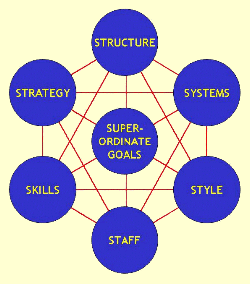
7S Framework
It's all very well devising a strategy, but you have to be able to implement it if it's to do any good. The Seven S Framework first appeared in "The Art Of Japanese Management" by Richard Pascale and Anthony Athos in 1981. They had been looking at how Japanese industry had been so successful, at around the same time that Tom Peters and Robert Waterman were exploring what made a company excellent. The Seven S model was born at a meeting of the four authors in 1978. It went on to appear in "In Search of Excellence" by Peters and Waterman, and was taken up as a basic tool by the global management consultancy McKinsey: it's sometimes known as the McKinsey 7S model.
Managers, they said, need to take account of all seven of the factors to be sure of successful implementation of a strategy - large or small. They're all interdependent, so if you fail to pay proper attention to one of them, it can bring the others crashing down around you. Oh, and the relative importance of each factor will vary over time, and you can't always tell how that's changing. Like a lot of these models, there's a good dose of common sense in here, but the 7S Framework is useful way of checking that you've covered all the bases.
The Seven Factors are:

| Strategy | A set of actions that you start with and must maintain |
| Structure | How people and tasks / work are organised |
| Systems | All the processes and information flows that link the organisation together |
| Style | How managers behave |
| Staff | How you develop managers (current and future) |
| Superordinate Goals | Longer-term vision, and all that values stuff, that shapes the destiny of the organisation |
| Skills | Dominant attributes or capabilities that exist in the organisation |
There's a lot more to the 7S framework of course, especially how you apply it in practice. It may appear as an outmoded concept in today's environment of "constant change and learning", but the basic principle that you've got to watch a lot of factors all the time as you implement any strategy still applies. Just don't let the apparent rigidity of the framework make you heavy on your feet.
For more about strategy and strategic management in general, look out "Strategic Management" by Dess & Miller (McGraw Hill 1993). It's not a bedtime read, but is a useful reference work of ideas and case studies. If you want more on the 7S model, read Richard Pascale's subsequent "Managing on the Edge" (1990).
© Chimaera Consulting Limited 1999.